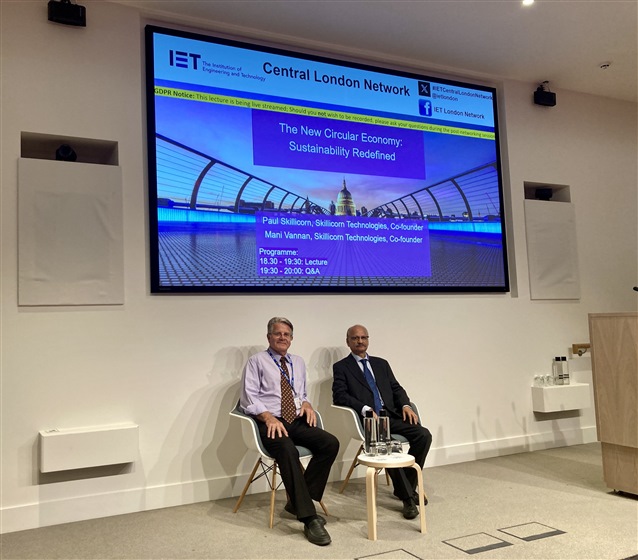It is not often a guest speaker waxes lyrical about Duckweed, but that is exactly what Paul Skillicorn did when talking to the IET Central London Network. Pauls opening slide showed four out of five genera of Duckweed, or as it is more formally known Lemnaceae and gave us a rundown of why he thought it was an extraordinary plant, the inner engine of The New Circular Economy.
Paul and his business partner Mani Vannan were at Savoy Place to tell us about the New Circular Economy, the problems it addresses and the solutions it delivers.

So, what is "The Circular Economy"? The Ellen McArthur Foundation defines it as:
The circular economy is a system where materials never become waste and nature is regenerated. In a circular economy, products and materials are kept in circulation through processes like maintenance, reuse, refurbishment, remanufacture, recycling, and composting. The circular economy tackles climate change and other global challenges, like biodiversity loss, waste, and pollution, by decoupling economic activity from the consumption of finite resources.
WE HAVE A MAJOR PROBLEM!
Paul took us on a whistlestop tour of problems and locations where The New Circular Economy could help:
- Global Warming and Rising Seas: Southern Bangladesh & Eastern India
- Industrial Wastes: Palm Oil Effluent Malaysia
- Industrial Wastes: Tannery Waste Bangladesh
- Dairy Wastes: California Dairy Farm
- Urban Wastewater: Yamina River New Delhi
The solution is truly circular starting with Waste and ending with Waste, with value in between:
Waste products > Breaking down those products> Extract energy & nutrients from those products > Rendering the resultant water as potable > Using that water to produce value added products and services > Providing jobs and wealth > Increasing consumption > Producing more Waste products.
The technology needed to close the circle, despite being based on Lemnaceae is quite complex with multiple inputs, related processes, and outputs. Paul did a fantastic job in taking the audience through these processes but the example of a project in Fayoum, Egypt demonstrated that it was not simply a case of waste in waste out!
The audience engaged with the Question-and-Answer session and for me the most insightful answer was to a question about the size of a Lemnaceae based plant. It is possible to create a vertical plant over several floors, and whilst there is a cost associated with building the infrastructure and continually pumping Waste Products upwards, the return on investment will be extremely quick (measured in a few years) compared to a traditional wastewater treatment plant.
Overall, in a world where access to clean drinking water is limited, anything that improves the situation is welcome, and here Skillicorn Technologies is taking a lead. This can only be congratulated.
View the recording of The New Circular Economy: Sustainability Redefined Session below:
And don’t forget to leave a comment below!